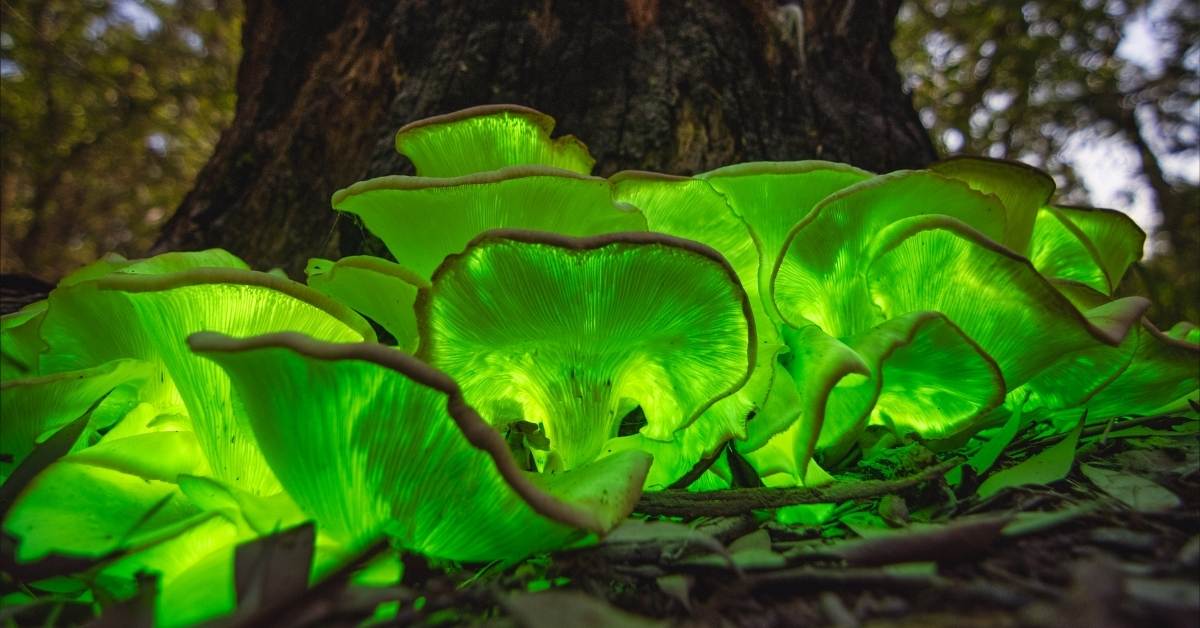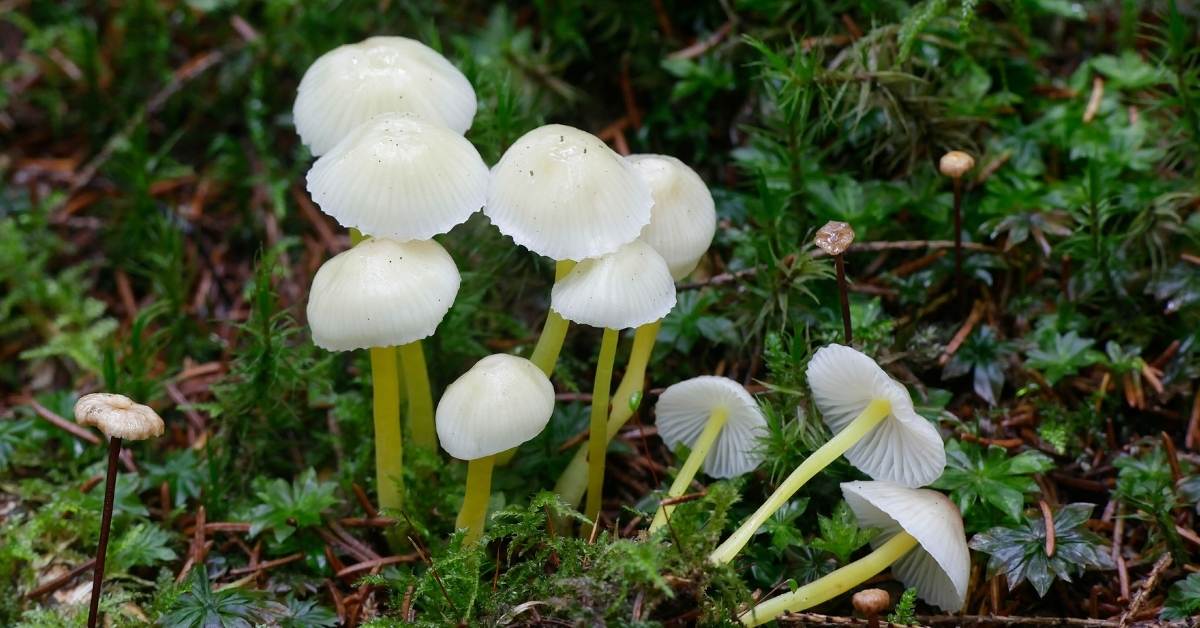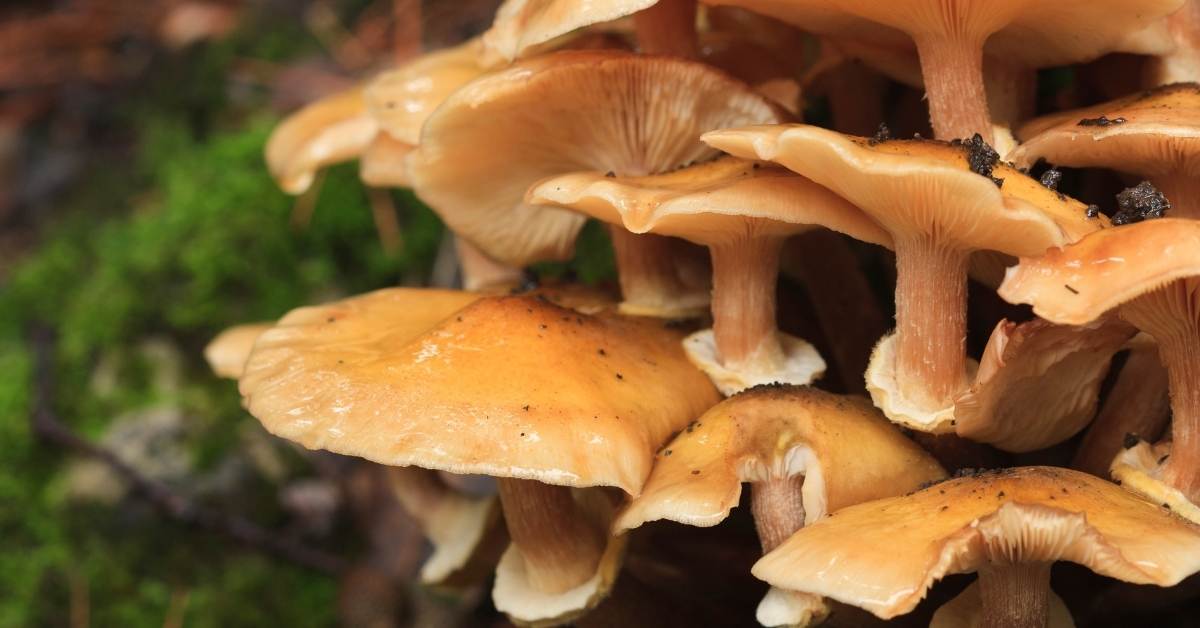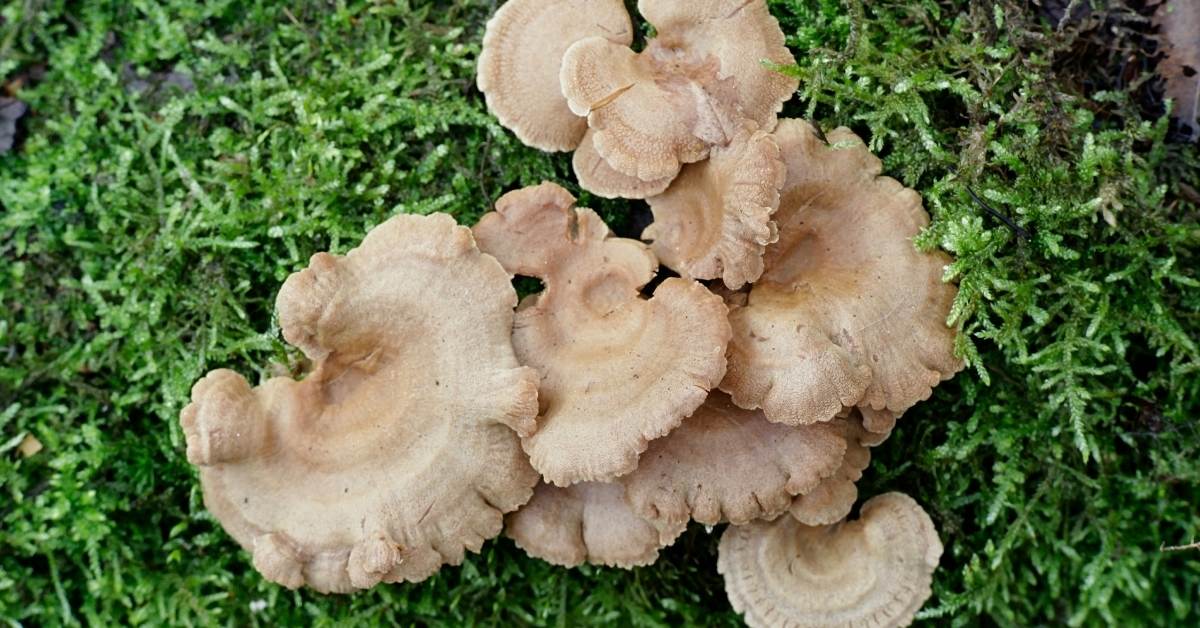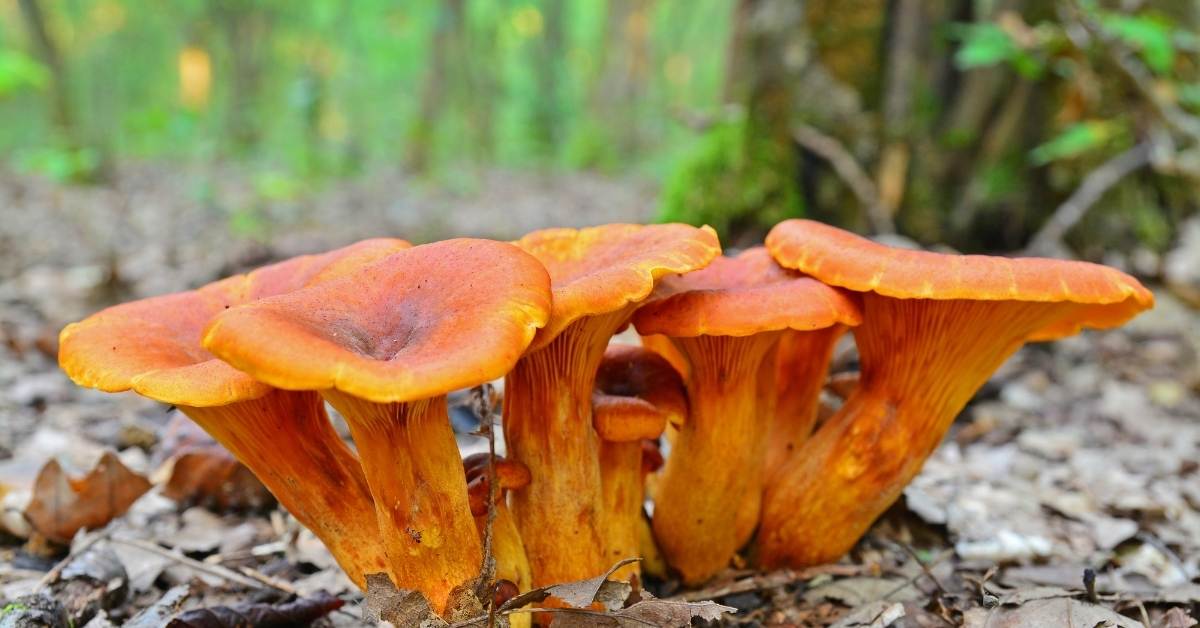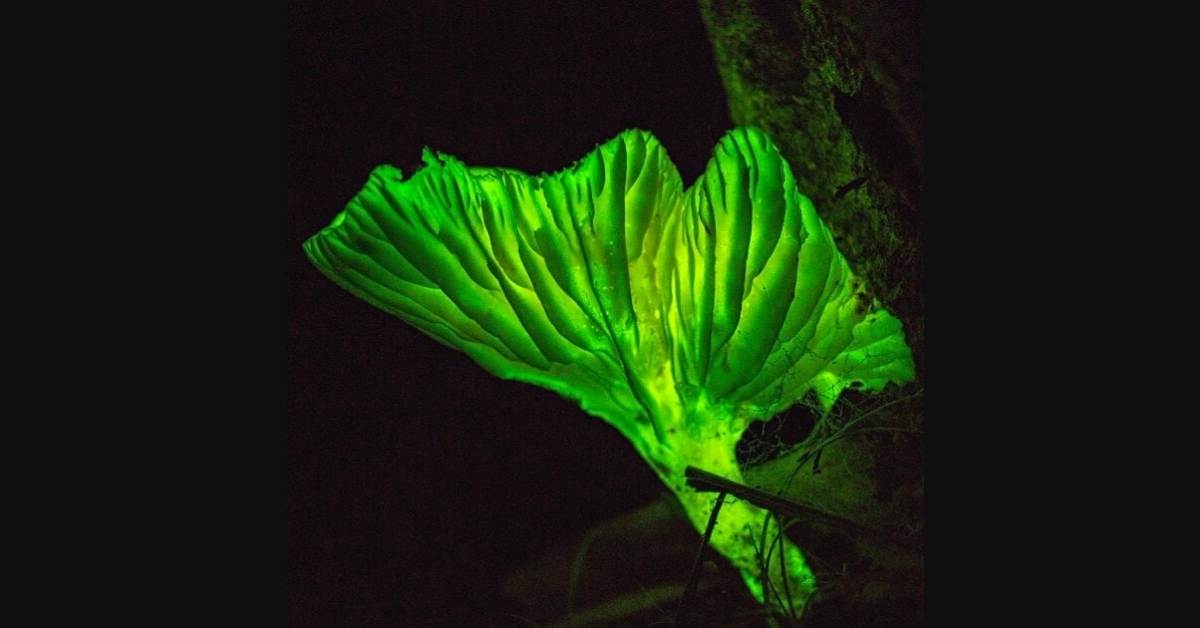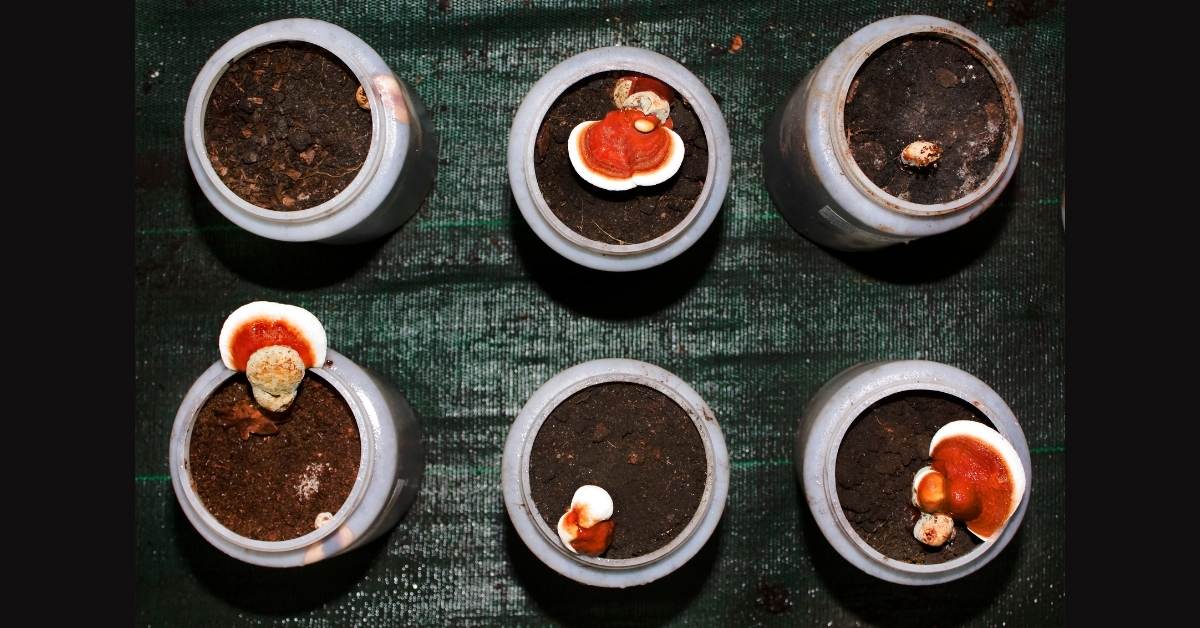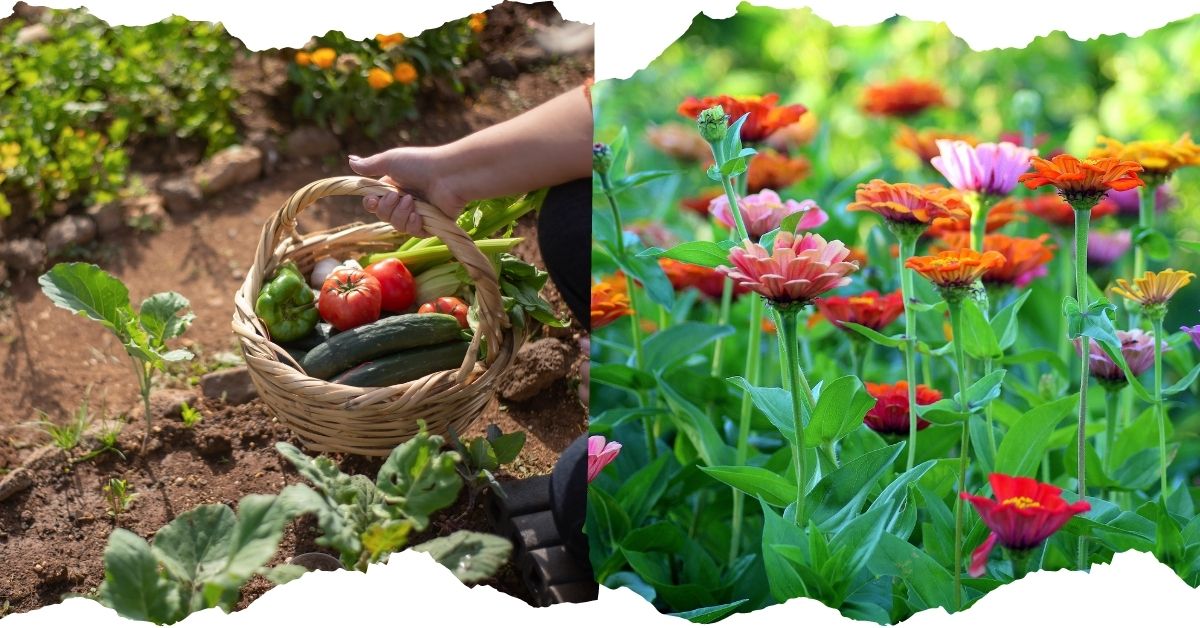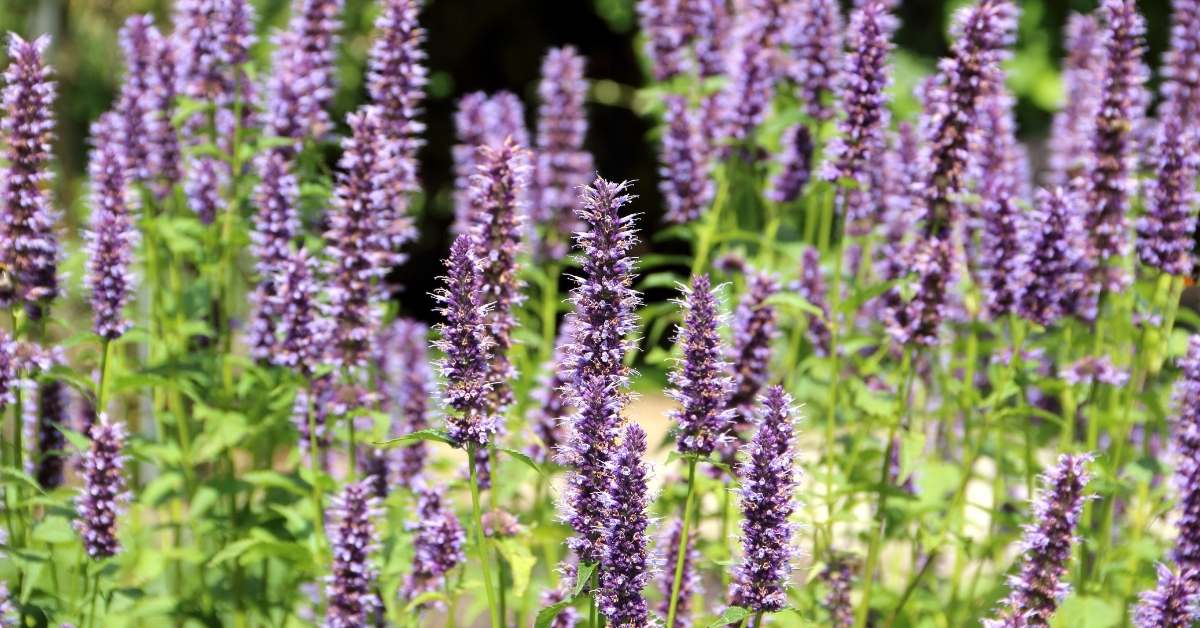Luminescent mushrooms (bioluminescent mushrooms) glow in the dark. Here you can find everything about the different species, breeding, and cultivation of these bizarre mushrooms.
Mushrooms that glow in the dark?
For many, that sounds like a dream or fairytale world. However, the immense variety of mushroom species (estimates are around 100,000) also contains more than 70 species that begin to glow at night. The technical term for glow in the dark is bioluminescence. But what is that exactly?
What is bioluminescence, and how does it work?
A living organism’s capacity to create and emit light, or send it out, is known as bioluminescence. This is made possible by chemical processes that occur within the body. With the aid of an enzyme (luciferase), a luminous molecule (luciferin) is oxidized to oxyluciferin (consumption of oxygen and energy).
When oxiluciferin breaks down, energy is released, which is transformed into light of a specific wavelength (max 530 nm) with minor loss. We see the light as green because of the wavelength.
Why do the mushrooms glow?
Nothing happens in nature without reason. The extraordinary appearance of the mushrooms also has a biological function. The emitted green light is visible to insects and attracts them.
Similar to the “bees and flowers” principle, the insects land on the mushrooms and, as they fly, transport spores that have stuck to them. Because of their conspicuous glow, the mushrooms have advantages in terms of reproduction and distribution.
Bioluminescent species: a small selection
The variety of bioluminescent mushrooms (syn. Luminous mushrooms) is very large. In the following sections, we will go into more detail on four representatives that occur in our latitudes.
The selected species belong to the mushrooms / “cap mushrooms” (Basidiomycota).
Honey fungus (Armillaria mellea)
The honey fungus predominantly colonizes hardwood. It occurs mainly outside of closed forests. The species is widespread in North America, Europe and Germany and is relatively common everywhere. The fungus forms a whitish fan mycelium under the bark, which glows in the dark under certain weather conditions.
The fruiting bodies appear mainly in late summer and autumn, from June to November. They are edible but not really enjoyable in terms of taste. The term mycelium, which was just mentioned and will appear further in the article, stands for the network of fungal cells (also called hyphae) that are strung together in a thread-like manner and usually grow underground.
Curious: cultures of this kind were used in the first war submarines at the end of the 19th century as lighting for measuring devices and clocks.
Bitter Oysterling mushroom (Panellus stipticus)
Old trunks, stumps, and branches lying around are colonized by oaks and red beeches, and other hardwoods. This luminous representative is rarely found on softwood. The bitter dwarf ball can be found in Australia, Pakistan, North Asia, North America, North Africa, the Canary Islands, and throughout Europe.
In Scandinavia, its distribution area extends up to the 65th parallel. The species occurs in almost all forest types, parks, gardens, rows of trees, and also on solitary trees. Here mycelium and fruiting bodies glow in the dark. The fruiting bodies appear all year round. They are not poisonous but inedible and, therefore, unsuitable as edible mushrooms.
However, many species do not thrive in the Central European climate. They prefer warmer, more humid climates. This includes, for example:
Jack-o’-lantern mushroom (Omphalotus olearius)
The heat-loving dark olive tree funnel is widespread in the Mediterranean area; it is very seldom to be found in Central Europe. The preferred habitat of this luminous representative is deciduous trees. It usually grows in tufts on olive trees, sometimes also on oaks or sweet chestnuts.
This bioluminescent mushroom appears from July to October and is poisonous, although not fatal. In this species, the mycelium and the lamellae glow.
“Flor de coco” (coconut flower) (Neonothopanus gardneri)
This bioluminescent mushroom is one of the most luminous and is (as the name suggests) mainly found in Brazilian coconut forests. Here it grows at the foot of the coconut palms. Unfortunately, you cannot buy spores or mycelium to grow this magnificent species at home.
Ghost Fungus
Ghost fungus is a common name for several species of fungi that belong to the genus Omphalotus. They are found in Australia, Asia, Europe, and North America. They grow on dead or dying wood and produce a greenish glow at night. The glow is caused by a chemical reaction between luciferin and luciferase, two compounds that are also found in fireflies. Ghost fungus is poisonous and should not be eaten.
Bleeding fairy helmet
Bleeding fairy helmet is a rare and endangered species of fungus that is native to Brazil. It has a bright red cap that bleeds when cut or bruised. It also emits a faint green light from its gills. The bioluminescence is thought to attract insects that help disperse its spores. The bleeding fairy helmet is edible but not very tasty.
Green Pepe
Green Pepe is a nickname for Mycena chlorophos, a species of fungus that grows in tropical and subtropical regions of Asia, Australia, and South America. It has a pale brown cap and a thin stem that glow green in the dark. The bioluminescence is strongest when the mushroom is young and fresh and fades as it ages or dries out. Green Pepe is edible but has no distinctive flavor.
Foxfire
Foxfire is a term for the bioluminescence produced by various species of fungi that colonize rotting wood. It is also known as fairy fire or will-o’-the-wisp. It can be seen in forests around the world, especially in humid and warm climates. The glow is usually blue, green, or yellow, depending on the species and the environment. Foxfire is not harmful to humans or animals, but some of the fungi that produce it may be toxic if ingested.
How to grow bioluminescent mushrooms
A couple of the species described are freely available and can be easily grown at home, or to stick with the correct choice of words: they can be grown.
If you want to grow glowing mushrooms at home, you can either fall back on spores of the desired type or mycelium. The use of mycelium is particularly recommended for beginners but also experienced mushroom lovers.
Spores are very susceptible to contamination – therefore, you must carry out the work in a sterile manner. However, this isn’t easy to do in most households.
Mycelium is available in various forms on the Internet or in special shops. There are mycelium syringes, inoculation dowels, wooden trunks, pure cultures in Petri dishes, and ready-made kits/glass cultures. Inoculation dowels have proven to be particularly insensitive and versatile.
Inoculation dowels are small wooden dowels with the mycelium growing through them. For example, they can be used for growing on logs or in mason jars. The cultivation of wooden trunks is particularly suitable for species whose fruiting bodies glow. Species with glowing mycelium do particularly well in mason jars.
Growing bioluminescent mushrooms on tree trunks
In addition to the inoculation dowels, only a log is required. Deadwood is best. Depending on the type, it should be noted which types of wood are preferred as a substrate. Appropriate holes are drilled in the trunk with a commercially available drill, and the inoculation dowels are inserted, if necessary, with the aid of a hammer.
The holes can then be sealed with wax, foil, or tape. Then it is time to wait. With climate-friendly species such as Armillaria mellea, old tree stumps can be inoculated in the garden. At night, your garden is transformed into a shimmering wonderland. Panellus stipticus makes streaky roots particularly attractive as an eye-catcher in terrariums.
Grow glowing mushrooms in mason jars
Growing in a mason jar is a bit more complicated compared to the tree trunk method. But the effort is rewarded.
Required materials:
Pressure cooker
- Substrate container (mason jar)
- Substrate and raw materials (for approx. 2 kg wood substrate):
- Wood chips 320 g
- Wheat Bran 170 g
- Sawdust 650 g
- Plaster of Paris 25 g
- Water 820 g
The wood chips are completely covered with cold water and soaked overnight. The wood chips are then allowed to drain over a sieve for 15 minutes. Here, too, you must pay attention to ensure that a suitable type of wood is used as the substrate.
Wheat bran, sawdust, and gypsum are now weighed, mixed, and added to the damp wood chips. Finally, add the specified amount of water, and everything is mixed properly. The substrate is now poured into the previously thoroughly cleaned mason jars.
The jars are sealed and placed in a pressure cooker. This is filled with so much water that the glasses are half covered. The whole thing is boiled for at least an hour to sterilize the substrate.
When the glasses with the substrate have cooled down (room temperature), one or more inoculation dowels can be added. Then the jar is closed again. It takes around 3 to 6 weeks for the whole thing to grow through nicely. The more inoculation anchors are used, the faster it goes.
Such shining glasses are very special gifts for friends or acquaintances. A glass with the mycelium of a species like Panellus stipticus arouses great astonishment, especially in children, and is a beautiful and natural alternative to the night light in the children’s room. In this form, Panellus stipticus lights up for approx—3 to 6 months.
Tip: If the inoculation dowels get into the jar, there is a risk of contamination. Therefore, you should work in the cleanest possible place. The area below an extractor hood is best suited for this. To do this, set the trigger to full power, disinfect your hands, open the lid, and, as quickly as possible, into the glass with the dowels.
Storage of the mycelium
The mycelium and the spores can be stored at cool temperatures and in the dark, for example, in the refrigerator. Spores can thus retain their ability to germinate for months. The mycelium can be stored for several weeks to months, depending on how much substrate and oxygen are available.
If you liked the post on bioluminescent mushrooms and how to grow and care for them, please share it by using one of the social media buttons beloved.
Where to buy bioluminescent mushroom spores?
If you’re looking to buy bioluminescent mushroom spores, there are a few online retailers that you can check out. Etsy, Amazon, and Everything Mushrooms are all reputable sellers that offer a variety of bioluminescent mushroom spores.
When you’re shopping for spores, it’s important to read the seller’s reviews carefully to make sure that you’re getting a quality product. You should also ask the seller any questions that you have about the spores before you make a purchase.
Once you’ve found a reputable seller and you’ve placed your order, you’ll need to follow the instructions that come with the spores carefully. This will help you to grow healthy and vibrant bioluminescent mushrooms.
Growing bioluminescent mushrooms can be a fun and rewarding hobby. With a little care and attention, you can have your own glowing garden in no time.
Conclusion
Bioluminescence is a fascinating phenomenon that occurs in some living organisms, including more than 70 species of mushrooms. These mushrooms glow in the dark due to a chemical reaction that helps them attract insects and spread their spores. They come in different shapes, colors, and sizes and can be found in various habitats around the world.
Some of them are edible, but others are poisonous or tasteless. You can grow bioluminescent mushrooms at home using inoculation dowels and a suitable substrate, or you can admire them in nature or in terrariums. Bioluminescent mushrooms are a beautiful and mysterious gift from nature that can brighten up your garden, your home, or your night. Happy glowing!
What is the purpose of bioluminescence in mushrooms?
Bioluminescence in mushrooms is a way of attracting insects that can help spread their spores. It also makes them more visible to humans and animals, which may have positive or negative effects depending on the species.
How can I grow bioluminescent mushrooms at home?
You can grow bioluminescent mushrooms at home by using inoculation dowels, which are small wooden sticks that contain the mycelium of the mushroom. You can insert them into logs or jars filled with a suitable substrate, such as wood chips, sawdust, or wheat bran. You need to keep the substrate moist and sterile and wait for several weeks or months until the mycelium grows and produces fruiting bodies.
Are bioluminescent mushrooms edible?
Some bioluminescent mushrooms are edible, but others are poisonous or inedible. You should never eat a mushroom unless you are sure of its identity and edibility. You should also be aware that some mushrooms may lose their glow after cooking or drying. If you want to enjoy the bioluminescence of mushrooms, it is better to observe them in their natural habitat or grow them at home for decoration.
